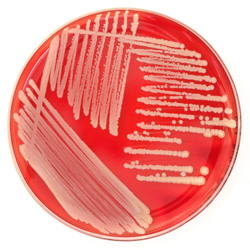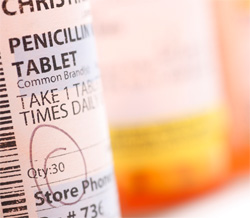
Chapter 13. Antibiotics and Resistant Bacteria
Antibiotics and Resistant Bacteria


Read the article below. Then answer the questions that follow.
Outsmarting bacteria
Because antibiotics sometimes are over-prescribed and also fed to the animals we eat, resistant strains of bacteria are developing faster than we can outsmart them. This is why researchers are exploring new kinds of antibiotics that contain peptides—short chains of amino acids that fight bacteria.
But before we examine these new disease fighters, let’s find out why antibiotics are so hard to develop.
An accidental discovery
Historically, the search for antibiotics always has been a game of chance. The British microbiologist Alexander Flemming made no progress in his search for a disease-fighter until an unknown mold took over a petri dish plated with Staphylococcus aureus, a bacteria that causes staph infections. Flemming named the unknown mold penicillin and demonstrated its ability to kill many different types of bacteria yet was largely non-toxic to humans. Even so, Flemming couldn’t isolate the antibiotic so that it remained active long enough for practical use. It would be another decade before Oxford University scientists Howard Florey, Norman Heatley, and Ernst Chain made a powder that kept its antibacterial power for longer than a few days.

After penicillin proved its value during World War II, a global search for new antibiotics erupted. Researchers tested the microorganisms found in soils and even fruit. This flurry of research led to the discovery of antibiotics like cephalosporin, which is produced by Cephalosporium molds, and tetracyclines, which are produced by Streptomyces bacterium.
Since then, the well of soil microorganisms has dried up.
Researchers screening soil continue to find the same antibiotic-producing microbes, over-and-over again. Only two new classes of antibiotics have been introduced since the 1960s. Most new antibiotic drugs are modifications of existing compounds and fight drug-resistant bacteria with little success.
From a business perspective, antibiotics aren’t as lucrative as some other drugs. For one, they are taken for a short period of time. Pharmaceutical companies often choose to spend money developing drugs for chronic disease, as these illnesses usually require life-long medication.
Unfortunately, bacteria don’t stop evolving in response to market factors, and resistant strains are on the rise. For example, 100,000 people die every year from infections acquired in hospitals. Many of these deaths have been attributed to a methicillin-resistant Staphylococcus aureus (MRSA).
Looking to gators and fungi for bacterial defense

Luckily, a few chance discoveries may be opening new doors. It turns out that leukocytes (white blood cells) culled from the American alligator (Alligator mississippiensis) produce small peptides capable of killing MRSA and other resistant germs. The discovery was made at Lake Charles, Louisiana-based McNeese State University by Dr. Mark Merchant, who says he never intended to study antibiotics. Instead, Merchant wanted to know why gators get so few infections after fighting each other in swampy, bacteria-filled waters.
“The gator immune system is strong because it has to respond to a broad spectrum of microbial assault,” says Merchant.
Another surprising discovery was made by the Denmark-based biotechnology company Novozymes. While searching for industrial enzymes, scientists at Novozymes discovered defensins in pine forest fungi. Defensins are short antibiotic peptides that poke holes in bacterial membranes. Although they have been found in many kinds of plants and animals, most defensins aren’t easily produced in pure concentrations—at least not with the biotechnology typically used to develop antibiotics.
The discovery of defensins in pine forest fungi was a breakthrough. Novozyme’s defensin, called plectasin, comes from the Pseudoplectania nigrella fungi. Plectasin is the first defensin discovered in fungi. Because many antibiotics came from soil molds, the biotechnology used to study and produce new drugs already existed. So far, plectasin has been easily integrated into fungal-based protein expression systems.
Researchers also are screening libraries of peptides for other drug candidates, but this process is a gamble. There is no way of knowing whether or not a compound will be toxic to humans, or if it will even work in “real life.”
Like gator peptides and plectasin, a lot of work needs to be done before these candidates are ready for the market.
© 2015 WH Freeman and Company.
13.1 Comprehension Questions
Answer the following questions to demonstrate your understanding of the article.
1.
Fill in the Blank:
Alexander Flemming discovered antibiotics by accident after he noticed an unknown mold, which he named , taking over a petri dish plated with Staphylococcus aureus bacteria.
2.
True/False:
To be successful, an antibiotic must harm bacteria but not be toxic to humans.
3.
According to the article, approximately how many people die each year from infections acquired in hospitals?
| A. |
| B. |
| C. |
| D. |
| E. |
4.
Which of the following statements best explains why the immune system of the American alligator (Alligator mississippiensis) is so well adapted to fight bacterial infections?
| A. |
| B. |
| C. |
| D. |
| E. |
5.
After World War II, there was a flurry of research activity that led to the discovery of new antibiotics, including cephalosporin, which is produced by Cephalosporium , and tetracyclines, which are produced by Streptomyces .
6.
True/False:
In recent years, scientists have found success screening soil for potential sources of new antibiotics.
7.
Why have pharmaceutical companies been reluctant to research and bring to market new forms of antibiotics?
| A. |
| B. |
| C. |
| D. |
| E. |
8.
Researchers at a biotechnology company based in Denmark accidently discovered defensins while searching for industrial enzymes. How do defensins kill bacteria?
| A. |
| B. |
| C. |
| D. |
| E. |
9.
Why have antibiotic resistant strains of bacteria developed?
| A. |
| B. |
| C. |
| D. |
| E. |
10.
A doctor sees a patient with flu-like symptoms and determines the patient has a viral infection. However, the patient demands the doctor write him a prescription for an antibiotic. Why should the doctor avoid writing a prescription for this patient?
| A. |
| B. |
| C. |
| D. |
| E. |
Activity results are being submitted...